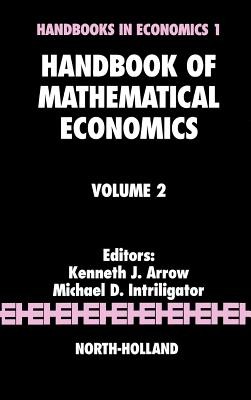
- We will send in 10–14 business days.
- Publisher: North-Holland
- ISBN-10: 0444861270
- ISBN-13: 9780444861276
- Format: 17.3 x 24.3 x 3.3 cm, kieti viršeliai
- Language: English
- SAVE -10% with code: EXTRA
Handbook of Mathematical Economics (e-book) (used book) | bookbook.eu
Reviews
Description
The Handbook of Mathematical Economics aims to provide a definitive source, reference, and teaching supplement for the field of mathematical economics. It surveys, as of the late 1970's the state of the art of mathematical economics. This is a constantly developing field and all authors were invited to review and to appraise the current status and recent developments in their presentations. In addition to its use as a reference, it is intended that this Handbook will assist researchers and students working in one branch of mathematical economics to become acquainted with other branches of this field. Volume 2 elaborates on Mathematical Approaches to Microeconomic Theory, including consumer, producer, oligopoly, and duality theory, as well as Mathematical Approaches to Competitive Equilibrium including such aspects of competitive equilibrium as existence, stability, uncertainty, the computation of equilibrium prices, and the core of an economy.
For more information on the Handbooks in Economics series, please see our home page on http: //www.elsevier.nl/locate/hes
EXTRA 10 % discount with code: EXTRA
The promotion ends in 21d.02:37:40
The discount code is valid when purchasing from 10 €. Discounts do not stack.
- Publisher: North-Holland
- ISBN-10: 0444861270
- ISBN-13: 9780444861276
- Format: 17.3 x 24.3 x 3.3 cm, kieti viršeliai
- Language: English English
The Handbook of Mathematical Economics aims to provide a definitive source, reference, and teaching supplement for the field of mathematical economics. It surveys, as of the late 1970's the state of the art of mathematical economics. This is a constantly developing field and all authors were invited to review and to appraise the current status and recent developments in their presentations. In addition to its use as a reference, it is intended that this Handbook will assist researchers and students working in one branch of mathematical economics to become acquainted with other branches of this field. Volume 2 elaborates on Mathematical Approaches to Microeconomic Theory, including consumer, producer, oligopoly, and duality theory, as well as Mathematical Approaches to Competitive Equilibrium including such aspects of competitive equilibrium as existence, stability, uncertainty, the computation of equilibrium prices, and the core of an economy.
For more information on the Handbooks in Economics series, please see our home page on http: //www.elsevier.nl/locate/hes


Reviews